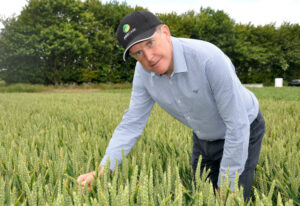Mike Thornton, head of crop production at ProCam, is advising growers to be flexible when it comes to managing later-drilled winter wheat crops.
He notes that the progress of drilling has varied widely across the country, with some seeing a repeat of last autumn’s washout, while other regions have made good progress.
“There’s a considerable area of crops to be drilled after this year’s increased maize area and after root crops. Later drilling situations demand a considered approach. Respond don’t react. This was something highlighted last season.”
To get the best out of later drilled crops, he suggests three areas for consideration.
Take a step back
“Later-drilled cereals need well-prepared seedbeds with a good tilth and good drainage. Often, crops that went wrong last season were ones that were mauled in.
“If you can’t prepare a good seedbed, be prepared to wait until you can. Depending on the variety and situation, winter wheat can still be drilled into January and potentially into February in some in cases, so there’s still time. And we saw last season that later-drilled wheat can yield well, with less pressure from grassweeds, barley yellow dwarf virus and Septoria.
“Clearly, it’s important to choose suitable varieties with later drilling, for example faster-developing types, and seed rates need increasing to account for heightened plant losses and reduced tillering. But these aren’t insurmountable.
“That said, if getting on the land becomes too difficult, consider waiting and drilling a good spring crop rather than a poor winter one. We can’t predict what spring 2025 planting conditions will be like. But again, 2024 showed how well some spring crops can perform.”

Don’t rule out the plough
“Ploughing can improve drainage and reduce compaction, and crops that were planted after ploughing last season often fared better.
“There’s a lot of soil damage left over from last season that needs rectifying, and there’ll be a lot of soil damage where maize crops have been harvested late in wet fields. So assess fields individually to judge whether the benefits of ploughing outweigh the costs.”
Tailor inputs
“Later-drilled crops generally have poorer root systems and fewer tillers. So a key aim is to stimulate lazy roots to become better at accessing nutrient reserves in the soil. Use soil testing to tell you the levels of key nutrients available. Then, manage each field on its merits.
“Ensuring spring nitrogen (N) is applied suitably early is an important foundation. But nowadays there are more sophisticated options for boosting growth than simply adding a bit more N. These include foliar-applied biostimulants, or soil-acting ones if plants are small; phosphite treatments for rooting; and foliar-applied endophyte bacteria that fix and provide N inside the plant. So seek advice on what’s appropriate for your fields.
“Later-drilled cereals are also more susceptible to slug damage. With a lot of weedy maize crops this season – due to missed herbicide applications – slug risks will be increased.
“Later drilling also shortens the weather window for applying herbicides before fields become too wet to travel. So it might be appropriate to make one robust pre-emergence herbicide application rather than gambling on being able to apply a pre-em followed by a later top-up. That’s probably something to take advice on.”


